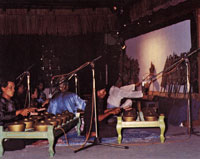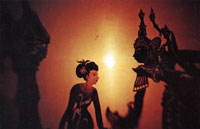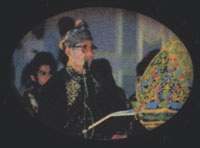
Wayang Kulit (Malay shadow play)

Wayang Kulit Siam is the most indigenous of these styles. It is principally performed in the state of Kelantan on the east coast of the Malay peninsula. Wayang kulit siam makes use of a local version of the Indian epic, Ramayana. Existing only in the oral tradition, this version is known as Hikayat Maharaja Wana. The Hikayat Seri Rama provides material for the principal story (cerita pokok). Local extensions of and accresions to the epic have resulted in the creation of a large number of Ramayana branch stories (cerita ranting). These have traditionally been more popular than the pokok story.
The wayang kulit siam orchestra consists of a pair of double- headed drums(gendang), a pair of single-headed goblet-shaped drums known as gedumbak, a pair or vertically standing drums (gedug) hit with beaters, a pair of hand small cymbals, (kesi) and a pair of inverted gongs canang), also beaten with sticks. and, finally, a pair of hanging knobbed gongs(tetawak).
In Malaysia, the most well-known style of wayang kulit is the Wayang Kulit Siam, practiced principally in the north-eastern state of Kelantan as well as in the Patani region of southern Thailand. Wayang Kulit Siam is performed in the Kelantanese-Patani dialect of Malay. Repertoire is largely based on Malay oral and literary versions of the ancient Hindu epic, the Ramayana, which tell of the adventures of Seri Rama and his consort Siti Dewi.
The main story-line, known as cerita pokok (trunk story), is performed occasionally; minor-tales and sub-plots involving the same characters, known as cerita ranting (branch stories), are far more popular. The principal performer in the Wayang Kulit Siam tradition is the dalang (master puppeteer). Besides animating the puppets with action and speech, the dalang provides narration and commentary, leads the musical orchestra and attends to the ritual aspects of a performance. Wayang Kulit Siam puppets are intricately carved and vibrantly painted two-dimensional figures made from leather. They comprise a vast array of character types including hero, heroine, warrior, clown, ogre, and magician.
Tok Dalang

The format on playing wayang kulit contains lots of entertainment and education
essence in it base on stories from the old folks and legend. Ritual performance,
puppets movement, speech, songs, background music, and visual are all important
elements in the playing format for the performance.
There are two techniques the dalang use while playing wayang kulit which are
puppets motion handling and coordination technique and story expending technique.
These techniques are based on format inside aturan dalang or guided dalang technique,
which only can be used by in a formal practice by the dalang. The result is
very interesting because almost every dalang in different plays has same similarity
of techniques. The education system for dalang contains sufficient subject learned
that covers techniques in playing and method on shaping the dalang personality.
As a solo actor, dalang plays a lot of character in a single show, acting as
part of the story, dialogue, singing and as a group leader in the show. The
Dalang also capable of playing most of the musical instrument, become a good
reference for ritual performance and also as a shaman or bomoh that helps to
contribute to society. Knowledge gained will be cultivate, gather and mix to
create a quality performance.
The audience are frequently believes that the plays by the dalang are self improvise.
Even though the play is based on improvise but it is guided improvisation. The
dalang acted spontaneously towards unexpected situation while the show is on
and improvise towards the actions in vocal and physical.
Therefore there is a fixed speech, fixed movement, fixed storyline and fixed character in a wayang kulit plays which becomes a guideline to control the self improvisation by the dalang. The dalang is the only actor in the play, does not interact with other actors but only interacts with him alone.
The unexpected situation could only be overcome with a strong mental and physical strength in a dalang. The dalang learned everything from his apprenticeship and observation in other dalangs. Therefore, dalang is the only person that can make the play interesting with in the show using his acting skills.
The guided dalang techniques still being followed and pass down from generation to generation until today
“Seniman Negara” Allahyarham Hamzah Amat

Hamzah Bin Awang Amat, Malaysia’ leading shadow play puppeteer was born in Kelantan in 1940. From an early age he developed an intense interest in the wayang kulit siam, the most important of Malaysia’s four styles of shadow play, which is associated principally with the state of Kelantan. Hamzah received his early training as a puppeteer (dalang) from his father, and at the age of 11 created his own experimental wayang kulit siam troupe with a few friends.
Hamzah Awang Amat later studied wayang kulit siam with Pak Awang Lah, the most famous of Kelantanese puppeteers. After initial lack of success, Hamzah managed to impress an international audience of scholars during the l969 Conference on the traditional music and theatre of South-East Asia, held in Kuala Lumpur. The exposure at the conference opened doors for Hamzah Bin Awang Amat to travel beyond Malaysian shores.
A group, known as the Seri Setia Wayang Kulit Troupe, was established and this
troupe, with Hamzah as leader, visited ten European countries in 1971 under
the sponsorship of UNESCO and the Malaysian Ministry of Culture, Arts and Tourism,
giving performances in 31 cities. In 1973 Hamzah performed in Russia and Turkey
and in 1974 visited Europe again as well as the United States. Closer to home
Hamzah and his troupe have performed in several Asian countries.
During the past few years Hamzah has, expanded his range of activities. He
has established himself as a puppet maker, a craftsman of traditional musical
instruments, a shaman, as well as a mak yong musician.
Both as performer and teacher, Hamzah has established a local as well as an
international reputation for authenticity of style and quality of performances.
He is one of the very few surviving puppeteers (dalang) in Malaysia who continue
to perform wayang kulit siam in the classical manner, and he is the only performer
who has managed to preserve the musical repertoire of the genre.
Hamzah bin Awang Amat has been a valuable resource person both for music and theatre researchers. For his active involvement in wayang kulit siam, he has received several local awards, as well as the ASEAN Cultural Award. He is currently attached to the National Academy of Arts (Akademi Seni Kebangsaan) in Kuala Lumpur. In 2000 Hamzah also received the Fukuoka Award for Culture.
Note: Pak Hamzah has passed away. He succumbed to a heart attack on January 1 2001, at the age of 60.
“Hikayat Seri Rama”
The Ramayana helped to mold concepts of state and kingship in Malaysia. The epic probably reached Malaysia by way of Javanese traders who brought their shadow play, Wayang Kulit. Many changes developed in the Malay version Ramayana and those changes depended upon the local traditions and politics. Religious beliefs also influenced these changes since the Malays were followers of Islam.
There are literary and folktale versions of Ramayana in Malaysia. The Hikayat
Seri Rama exists in both written and oral form, and the Wayang Kulit Siam is
a shadow play from Kelantan on the border of Malaysia and Thailand (Siam). The
Ramayana in Malaysia is used more for entertainment and social education rather
than for spiritual or religious purposes. Kelantan is strongly Islamic, but
it is also the main base for the Malay shadow puppet theatre.
The main purpose of the Hikayat Seri Rama is to show the ideals of righteousness,
love, loyalty, and selfless devotion. This Malay version has combined elements
of the Indian Sanskrit Ramayana with local traditions and beliefs to create
a highly developed story which is enjoyed by many.
All Kelantan dalangs (shadow puppet puppeteers) are Muslims. The wayang (shadow play) is disliked by the conservative Muslims. They criticize the rituals and practices associated with the art which appear to them to be outlawed by Islam. The religious conservatives are also concerned with the effect that the music has on the people and the dalang during the performance. They object to the trance-like effect which seems to be produced by the gamelan (gong orchestra). The dalang usually performs 200 - 300 shows a year and probably no more than two are held for purposes other than entertainment.
The literary and folktale versions include variations, changes, omissions, and
additions based upon the particular region. Another version entitled Wayang
Kulit Gedek appears to have come from Southern Thailand. In Malaysia, the Ramayana
episodes are divided into two categories, those that concern the fundamental
plot, pokok, (base,trunk) and those non-fundamental episodes, rantings (twigs),
which consist of Rama's adventures and those of the other main characters. These
extensive ranting stories are performed by local puppeteers (dalang) or performers.
In one of these rantings entitled Sita Dewi Dihalau some events associated with Sita differ greatly from Valmiki's Sanskrit Ramayana. At one point, after she has been rescued, Sita admits she painted a picture of her abductor Maharaja Rawana (Ravana). Seri Rama then beats her and kicks her violently until she is near death. At the end of the story Seri Rama wants Sita Dewi to return, but she indicates that Seri Rama must comply with several of her demands which he eventually fulfills. In the conclusion of Valmiki's Sanskrit Ramayana Sita rejects Rama's request to return to him and returns to mother earth. Sita is always depicted as a good and obedient daughter, a faithful wife, a mother, and as a courageous woman who stood up for the truth. But her character as a goddess or fertility divinity is not emphasized among Malay-Muslims.
The Malays do not look for the Hindu/Buddhist concepts of dharma, karma, and moksha in the hero Rama. They only view him as a righteous and virtuous model for mankind. With these traits he was able to triumph over evil. When comparing the Sanskrit Ramayana and the Hikayat Seri Rama we find they share the basic universal theme that goodness, righteousness, and justice will prevail over evil. These values and ideals appealed to the people in all the countries of South East Asia influenced by India.
Malay storytellers however show the legacy of their particular civilization in their version of the epic. Malay writers and storytellers produce variations in which Lakhsmana, the younger brother, becomes more important than Rama the elder prince. Rama, although righteous and virtuous was perceived to be weak and his character is often moved to the background. The younger Lakhsmana's courage and willingness to react decisively appear to be traits which are more appreciated by the Malays.